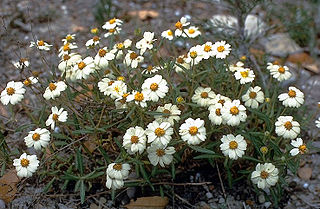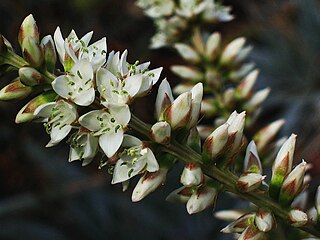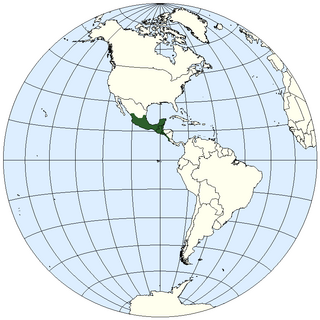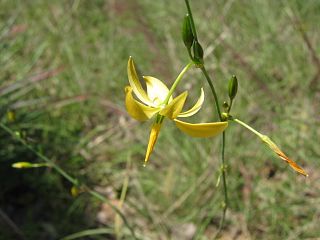
Lamanai is a Mesoamerican archaeological site, and was once a major city of the Maya civilization, located in the north of Belize, in Orange Walk District. The site's name is pre-Columbian, recorded by early Spanish missionaries, and documented over a millennium earlier in Maya inscriptions as Lam'an'ain. Lamanai is renowned for its exceptionally long occupation spanning three millennia, beginning in the Early Preclassic Maya period and continuing through the Spanish and British Colonial periods, into the 20th century. Unlike most Classic-period sites in the southern Maya lowlands, Lamanai was not abandoned at the end of the 10th century AD.

Mesoamerican languages are the languages indigenous to the Mesoamerican cultural area, which covers southern Mexico, all of Guatemala, Belize, El Salvador, and parts of Honduras, Nicaragua and Costa Rica. The area is characterized by extensive linguistic diversity containing several hundred different languages and seven major language families. Mesoamerica is also an area of high linguistic diffusion in that long-term interaction among speakers of different languages through several millennia has resulted in the convergence of certain linguistic traits across disparate language families. The Mesoamerican sprachbund is commonly referred to as the Mesoamerican Linguistic Area.

Melampodium is a genus of flowering plants in the sunflower family.

Hechtia is a genus of plants in the family Bromeliaceae, and is the sole genus of the subfamily Hechtioideae, containing 75 species. Its species are native to Mexico, Central America, and Texas.

The geography of Mesoamerica describes the geographic features of Mesoamerica, a culture area in the Americas inhabited by complex indigenous pre-Columbian cultures exhibiting a suite of shared and common cultural characteristics. Several well-known Mesoamerican cultures include the Olmec, Teotihuacan, the Maya, the Aztec and the Purépecha. Mesoamerica is often subdivided in a number of ways. One common method, albeit a broad and general classification, is to distinguish between the highlands and lowlands. Another way is to subdivide the region into sub-areas that generally correlate to either culture areas or specific physiographic regions.

The Huastec civilization was a pre-Columbian civilization of Mesoamerica, occupying a territory on the Gulf coast of Mexico that included the northern portion of Veracruz state, and neighbouring regions of the states of Hidalgo, Querétaro, San Luis Potosí, and Tamaulipas. The Huastec people were an early offshoot of the Maya peoples that migrated northwards.

Jarilla is a genus in the family Caricaceae of Brassicales.

Metallurgy in pre-Columbian America is the extraction, purification and alloying of metals and metal crafting by Indigenous peoples of the Americas prior to European contact in the late 15th century. Indigenous Americans had been using native metals from ancient times, with recent finds of gold artifacts in the Andean region dated to 2155–1936 BC, and North American copper finds being dated to approximately 5000 BC. The metal would have been found in nature without the need for smelting, and shaped into the desired form using hot and cold hammering without chemical alteration or alloying. As of 1999, "no one has found evidence that points to the use of melting, smelting and casting in prehistoric eastern North America."
Decachaeta is a genus of Mesoamerican flowering plants in the family Asteraceae.

Tridax is a genus of flowering plants in the family Asteraceae.
Otopappus is a genus of flowering plants in the tribe Heliantheae within the family Asteraceae, primarily Mesoamerican but with one species from Jamaica.

Perymenium is a genus of South American and Mesoamerican plants in the tribe Heliantheae within the family Asteraceae.

Gibasis is a genus of flowering plants within the Commelinaceae family, first described in 1837. It is native to the Western Hemisphere from Texas and the West Indies south to Argentina, with most of the species native to Mexico.

Echeandia is a genus of New World plants in the century plant subfamily within the asparagus family.

Axe-monies refer to bronze artifacts found in both western Mesoamerica and the northern Andes. Based on ethnohistorical, archaeological, chemical, and metallurgical analyses, the scholars Hosler, Lechtman and Holm have argued for their use in both regions through trade. In contrast to naipes, bow-tie- or card-shaped metal objects which appear in the archaeological record only in the northern Andean coastal region, axe-monies are found in both Mesoamerican and Andean cultural zones. More specifically, it is argued that the system of money first arose on the north coast of Peru and Ecuador in the early second millennium CE. In both regions, bronze was smelted, likely by family units, and hammered into thin, axe-shaped forms and bundled in multiples of five, usually twenty. As they are often found in burials, it is likely that in addition to their presumed economic use, they also had ceremonial value.

Traditional metal working in Mexico dates from the Mesoamerican period with metals such as gold, silver and copper. Other metals were mined and worked starting in the colonial period. The working of gold and silver, especially for jewelry, initially declined after the Spanish conquest of the Aztec Empire. However, during the colonial period, the working of metals rose again and took on much of the character traditional goods still have. Today, important metal products include those from silver, gold, copper, iron, tin and more made into jewelry, household objects, furniture, pots, decorative objects, toys and more. Important metal working centers include Taxco for silver, Santa Clara del Cobre for copper, Celaya for tin and Zacatecas for wrought iron.

The tlaximaltepoztli or simply tepoztli was a common weapon used by civilizations from Mesoamerica which was formed by a wooden haft in which the poll of the bronze head was inlaid in a hole in the haft. It was used for war or as a tool. Its use is documented by the Codex Mendoza and the Codex Fejérváry-Mayer. Tax collectors from the Aztec Empire demanded this kind of axe as tribute from the subjugated kingdoms. In Aztec mythology, the tepoztli was used by the god Tepoztécatl, god of fermentation and fertility. In Codex Borgia he is represented with a bronze axe.
The following television stations broadcast on digital channel 34 in Mexico:
The following television stations broadcast on digital channel 26 in Mexico:
















